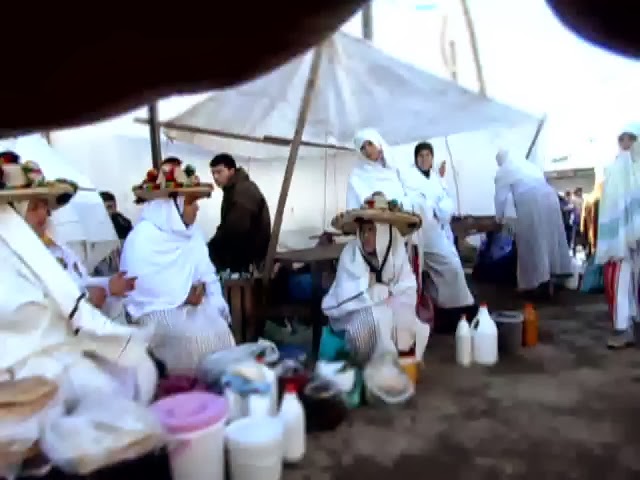 |
| Old Postcard with a Circumcision Procession |
Circumcision is one of the three major ceremonies in a Moroccan man’s life. The others are birth and marriage. In fact, a Moroccan circumcision is similar to a wedding: The young man is dressed like a bridegroom and the ritual follows the outlines of a marriage ceremony. It is an important ritual because Muslim women are not allowed to marry uncircumcised men. The ceremony can be simple or elaborate, private or public according to one’s preferences and circumstances. It usually occurs between ages one and seven. Families may wait until they can afford to give their boys a good party. If the family opts for a party, it will be after the incision has healed. The boy is meant to feel like a Prince during his passage from childhood to adulthood. Processions on horseback such as in the photo above are still practiced in families with the means to do so.
The circumcision to which I was invited had no procession on horseback. The honoree, his mother and sister, took the front stairs to descend into the living room of their home. Only female family members and friends were invited to this ceremony. All the servers, entertainers, dressers and photographers were women. The few men present were relegated to the anteroom, where they waited to drive their relatives home. My Moroccan-American husband told me that this ladies’ night out after the operation did not exist when he was a child. His parents had a small circumcision party for him with both men and women guests. Perhaps, it is a customs in Northern Morocco and not in the Gharb where he grew up.
This circumcision was on Moroccan time. I arrived at the specified time of 9:30 PM and waited until midnight for the young gent, his mother and his sister to join the party. Guests arrived in rich caftans
 |
|
This is the sort of
dress and makeup worn by the mother and daughter of the honoree
|
 |
|
These are the sort of sweets served at
circumcisions
|
and impressive jewelry, often acquired when they married. They made grand entrances and seated themselves at ornately decorated tables. While we waited for the honoree, waitresses in matching outfits paraded around us with trays of sweets, soft drinks and party favors. An all-female orchestra played traditional songs at a level usually found at heavy metal concerts. Dinner was served at 1:30 AM and the party lasted into the night.
Before the arrival of the little gent, waitresses dressed in black pants, black vests and white shirts, passed food and drink on huge silver trays. Despite the modern dress, they reminded me of medieval pages at a royal banquet. They walked solemnly in a line to bring soft drinks, sweets and party favors on huge silver trays. The drinks consisted of water, mint tea, fruit juice, and soda pop. For hors d’oeuvres, they passed out pastries, chocolates and dates stuffed with walnuts. For party favors, each lady received little Korans on miniature tripods, little hands of Fatima, red boxes filled with pastries and pink baskets filled with sugar coated almonds. While awaiting the honorees, women got up to dance. They were terrific dancers but I looked like an aging hippie reliving the 60’s. I did my best teetering on borrowed gold sandals.
At midnight, the little gent appeared with his mother and little sister. The boy was dressed in a white two piece rob (gandoura) with gold braid; the mother and daughter wore in matching red silk caftans
 |
| The sort of throne used during the circumcision |
with matching embroidery, belts and crowns. The ladies in the family were camera ready with elaborate coiffures and professional makeup.
A beautiful mistress of ceremonies of undefinable age led the mother and the boys through various rituals and set up many photo opportunities. She also serenaded the little honoree in a voice that threatened to shatter the tea glasses. At one point, four strong women in white caftans hoisted the little boy into a litter or palanquin. It was a splendid contraption reminiscent of the Taj Mahal. They proceeded to parade the little boy around the crowded living room, knocking into chandeliers and guests as they went by. The little boy loved it. He laughed and waved like the best British Royal. Then the boy, his mother and sister sat still on a large throne for more picture taking. As he sat, the little boy sucked on his pacifier and twirled his leather slippers (belga). For one part of the ceremony, he had to hold rose petals for what seemed an eternity and scatter them over his mother’s head. It is difficult to imagine American children being so poised and compliant.
Before they served the lavish meal, the waitresses covered the embroidered tablecloths with plastic sheeting. No plates, forks or napkins appeared. That worried me because I am not an expert in eating with my hands and I was wearing a magnificent wedding caftan lent by a friend. (I had arrived in my best party dress but was told that it was not good enough.)
There were two main courses, lamb with apricot and almonds and roast chicken. Most of the ladies were unable to do justice to the tender chicken. Dessert consisted of fresh fruit and more rich pastries. Throughout the meal, five lady percussionists filled the room with heavily amplified sound. According to a Moroccan friend, they played music and sang popular songs from the time of her grandmothers. Two lady photographers and a female videographer recorded every single minute of the event. The hosts did not want to publish their photos on the internet so I have made do with generic photos.





























